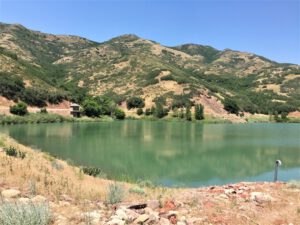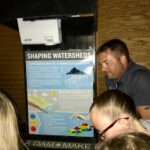Many of our nation’s public utilities face the challenge of adaptability. Aging infrastructure, increases in storm intensity, and the need to ensure a ready workforce are hurdles utility managers have to overcome to provide reliable services. Salt Lake City, Utah, deals with each of these challenges as it provides water, wastewater, and storm water services to its booming population.
Tyler Young, writer for Municipal Water Leader, had the opportunity to speak with Laura Briefer, director for Salt Lake City Public Utilities. Appointed by Salt Lake City Mayor Jackie Biskupski in 2016, Ms. Briefer is the first woman to serve as director of the Department of Public Utilities in its 142-year history. Ms. Briefer discusses Salt Lake City Public Utilities’ challenges and the plan of action it has undertaken to address them.
 Tyler Young: Please tell us about your background and your time at Salt Lake City Public Utilities.
Tyler Young: Please tell us about your background and your time at Salt Lake City Public Utilities.
Laura Briefer: My background in the water industry started 10 years ago when I was hired as a special projects manager at Salt Lake City Public Utilities. I have a bachelor’s degree in environmental studies and a master’s degree in public administration. My first role for the department was to manage the initiatives that required extensive stakeholder involvement, such as climate vulnerability assessments or large-scale watershed management planning. Laura Briefer of Salt Lake City Public Utilities After, I became a water resources manager; my role was to manage a portfolio of water resources in terms of water rights administration, water quality, source water protections, and the water treatment and distribution process. I then became the deputy director of the department, which is a position appointed by the mayor, and eventually was appointed director of the department.
Prior to being in the water industry, I spent some time as an assistant city manager for a small city in Utah, and before that, I was an environmental consultant working on several regulatory environmental projects across the country.
Tyler Young: Can you tell us a bit about Salt Lake City Public Utilities and its founding?
Laura Briefer: Salt Lake City Public Utilities is the oldest retail water provider west of the Mississippi. The water department for Salt Lake City began prior to statehood. The water supply operation has been in operation for more than 170 years. We can trace our history to the arrival of Brigham Young and the Mormon pioneers who came to settle in the Salt Lake Valley. Over time, it became part of city government, and we also were given additional municipal utilities to manage, such as sewer, storm water, and street lighting.
I’ve been working on a large state water rights adjudication process within our region. One of the most interesting Salt Lake City water rights I found was dated July 24, 1847, which was the day the Mormon pioneers entered the valley.
One of our most aggressive initiatives is the protection of our water sources from pollution. The watersheds that provide the drinking water are a part of the Wasatch-Cache National Forest. You can look back at our records for the mid- to late 1800s and see that drive to protect the quality of water for the public. It is a huge testament to the legacy of good policies.
Tyler Young: Please tell us about your region and the people you serve.
Laura Briefer: Salt Lake City is the largest city in Utah and is also the state’s capital city. It is situated within the Salt Lake Valley in the arid northern region of Utah, where rainfall is sparse. (Utah is the second-driest state in the nation). Like many areas of the intermountain West, our regional hydrology is snowpack dependent. The Salt Lake City Department of Public Utilities provides culinary water to the entire population of Salt Lake City as well as some areas outside the city boundaries. The city’s population is about 340,000 people, encompassing growing residential communities, industries, and commercial and institutional customers. Our service area is about 134 square miles. Our wastewater, storm water, and street lighting is just inside of Salt Lake City’s boundaries; in totality, about 200,000 people receive our services.
Tyler Young: What are some of the interesting projects and initiatives you are completing?
Laura Briefer: We are in the middle of a lot of generational planning regarding our water resources. Some large and exciting initiatives we are pursuing include an initiative to update our water supply and demand plan to account for land use and population growth so that we can integrate climate change effects. These climate change effects include a decreasing snowpack and longer and deeper droughts. Our updated water supply plan will look ahead 50 years, incorporating growth and climate change.
Additionally, we have a watershed management plan that we are updating to look at emerging vulnerabilities in terms of source water protection, the resulting management strategies, and the public policies we have put into place to continue to protect our water resources long into the future.
Another big planning effort is our storm water management plan, into which we are incorporating climate change. We anticipate storm intensification to affect the drainage systems by causing more intense flash flood events. We are also producing a drought contingency plan that will align well with our water supply and demand planning process, and we are compiling an integrated water management plan. All our water utilities operate within the same watershed, and I think there is a way for us to look creatively at how we manage water within each of those systems in order to better comply with the Clean Water Act and create more benefits for the public.
As far as capital projects, we have more infrastructure projects than we have ever had in our history. One of the big drivers is that our infrastructure needs to be replaced, especially on the treatment plant side. The plants were constructed in the 1950s and 1960s and now need substantial work. We are rebuilding our wastewater treatment plans to meet the new nutrient requirements under the Clean Water Act and are making sure we have more sustainability in terms of energy use and renewable energy generation. We also want to make the facility more resilient for flooding events.
 Tyler Young: What are some of the biggest challenges you are facing as a public utility?
Tyler Young: What are some of the biggest challenges you are facing as a public utility?
Laura Briefer: Climate change is one of the biggest challenges we face. It needs our full attention and planning. Similar to the many municipalities across the country, keeping up with maintenance and implementing new infrastructure can be expensive. Tied with the infrastructure piece are water rates and the growing concern about the affordability of sewer and water for nondiscretionary use. As our population grows and water resources are affected by that growth, the whole system is becoming more stressed. I think one of our challenges is to make sure that we are really engaged with the public and the community in the future so that we do not have major conflicts around water in our region.
Tyler Young: Where do you see the industry going in the future?
Laura Briefer: I see the industry recognizing the linkages between all the different areas of water management and conducting more and more case studies related to how integrated water management is being implemented. I think the industry is becoming much more aware of the critical need for public engagement and accountability. We have seen many mid-sized to larger municipal public utilities create positions within their utilities to deal with public engagement and public relations. I see us becoming more and more accountable, transparent, and engaged with our community. It is so important to have a sound foundation of trust with your community, and that means there is a lot of back and forth between the utility and the community that depends on the services. We are trying to figure out the best way to have that back and forth with our community.
Tyler Young: What advice do you have for individuals wanting to get into the industry?
Laura Briefer: I think one piece of advice I have is that people need to make sure they are coming into the industry with an open mind. We have a great need for good managers— people who understand what it means to manage diversity within the community and in the organization. It is so important to set the stage for accountability. Individuals wanting to get into the industry need to be well rounded in experience and education. If you are an engineer, make sure you understand what the legal frameworks and policy-setting frameworks are. If you have a public administration background, make sure you integrate it with the technical side of the industry. It is critically important that those in our industry are well rounded and open minded.
Laura Briefer is the director of Salt Lake City Public Utilities. She can be reached at Laura.Briefer@slcgov.com.



